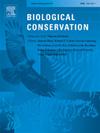Bias in neotropical and reef biodiversity monitoring programs may prevent detecting changes in species diversity through time
IF 4.4
1区 环境科学与生态学
Q1 BIODIVERSITY CONSERVATION
引用次数: 0
Abstract
Biodiversity monitoring networks are essential to quantify changes in biodiversity over time. Despite the importance of monitoring, studies using these data fail to find the widely accepted negative human impact on biodiversity, raising concerns about potential sampling issues in monitoring programs. To quantify the magnitude of these biases and their implications for future studies, we investigated the spatial, temporal, and taxonomic distribution of biodiversity monitoring networks in the Neotropics. Our dataset spans 59 years (1961–2020) and includes data from 30 countries and terrestrial and marine ecosystems. To understand how the duration of the time series could impact future studies, we simulated communities under different levels of colonization and extinction. We then evaluated whether colonization and extinction could be reliably estimated from a short time series. Most networks cover specific geographical regions (overrepresentation in southeastern Brazil), are short (<10 years), and focus on plants and mammals on land and fishes on marine reefs. In addition, most studies (81 %) sample areas with no significant habitat changes over time, which is significantly different from a random sampling expectation. We found long-term data (>50 years) to be important to achieve greater accuracy in temporal analyses, but short time series would still produce unbiased measures of colonization and extinction. Because monitoring sites are primarily in areas with low human impact and are restricted taxonomically, future studies using these data are unlikely to detect most species extinctions. Biodiversity monitoring programs should aim for a more equitable geographic distribution of projects and diversify taxonomic and geographical representation.

新热带和珊瑚礁生物多样性监测项目的偏差可能会阻碍物种多样性随时间的变化
生物多样性监测网络对于量化生物多样性随时间的变化至关重要。尽管监测很重要,但使用这些数据的研究未能发现广泛接受的人类对生物多样性的负面影响,这引起了人们对监测计划中潜在采样问题的担忧。为了量化这些偏差的程度及其对未来研究的影响,我们调查了新热带地区生物多样性监测网络的空间、时间和分类分布。我们的数据集跨越59年(1961-2020年),包括来自30个国家以及陆地和海洋生态系统的数据。为了了解时间序列的持续时间如何影响未来的研究,我们模拟了不同程度的殖民和灭绝下的群落。然后,我们评估了是否可以从短时间序列中可靠地估计殖民化和灭绝。大多数网络覆盖特定的地理区域(巴西东南部的代表性过强),时间较短(10年),并且关注陆地上的植物和哺乳动物以及海洋珊瑚礁上的鱼类。此外,大多数研究(81%)的样本地区没有明显的栖息地随时间变化,这与随机抽样的期望有很大不同。我们发现长期数据(50年)对于获得更高的时间分析准确性很重要,但短时间序列仍然可以产生无偏倚的殖民和灭绝测量。由于监测点主要位于人类影响较小的地区,并且在分类上受到限制,因此利用这些数据进行的未来研究不太可能发现大多数物种灭绝。生物多样性监测项目的目标应该是使项目的地理分布更加公平,并使分类和地理代表性多样化。
本文章由计算机程序翻译,如有差异,请以英文原文为准。
求助全文
约1分钟内获得全文
求助全文
来源期刊

Biological Conservation
环境科学-环境科学
CiteScore
10.20
自引率
3.40%
发文量
295
审稿时长
61 days
期刊介绍:
Biological Conservation is an international leading journal in the discipline of conservation biology. The journal publishes articles spanning a diverse range of fields that contribute to the biological, sociological, and economic dimensions of conservation and natural resource management. The primary aim of Biological Conservation is the publication of high-quality papers that advance the science and practice of conservation, or which demonstrate the application of conservation principles for natural resource management and policy. Therefore it will be of interest to a broad international readership.
 求助内容:
求助内容: 应助结果提醒方式:
应助结果提醒方式:


